The Control of Postharvest Soft Rot Caused by Rhizopus stolonifer on Kokei No. 14 Organic Sweet Potato Roots by Carvacrol, Thymol, and Thyme Oil
Abstract
1. Introduction
2. Materials and Methods
2.1. Essential Oils, Pathogens, and Roots
2.2. Analysis of the Volatile Components of Thyme Oil Using the Gas Chromatography–Mass Spectrometry (GC-MS) System
2.3. Determining the Contact- and Vapor-Phase Activities of EOs Against R. stolonifer, Mycelial Growth, and Spore Germination
2.4. The Effects of Carvacrol, Thymol, and Thyme Oil Vapors on the Morphological Changes in R. stolonifer
2.5. Effects of Carvacrol, Thymol, and Thyme Oil Vapors on the Control of Rhizopus Rot on Artificially Inoculated Roots
2.6. The Effects of Carvacrol, Thymol, and Thyme Oil Vapors on the Control of Rhizopus Soft Rot on Naturally Infected Roots
2.7. The Effects of Carvacrol, Thymol, and Thyme Oil Vapors on the Quality of Sweet Potato Roots
2.7.1. The Evaluation of Root Weight Loss and Color Change
2.7.2. Evaluation of Root Firmness, Starch, Carotenoids, and Flavonoids
2.7.3. Odor Analysis by Electronic Nose and Sensory Panel Test
2.8. Data Analysis
3. Results and Discussion
3.1. Component Analysis of Thyme Oil Using GC-MS System
3.2. Antifungal Effects of EOs on the Mycelial Growth and Spore Germination for R. stolonifer Under In Vitro Conditions
3.2.1. Isolation and Identification of R. stolonifer
3.2.2. Preliminary Assays of Selected EOs Against R. stolonifer Mycelial Growth In Vitro
3.2.3. Antifungal Activities of Carvacrol, Thymol, and Thyme Oil Against R. stolonifer Mycelial Growth In Vitro
3.3. Antifungal Activities of Carvacrol, Thymol and Thyme Oil Against R. stolonifer Spore Germination In Vitro
3.4. Effects of Carvacrol, Thymol, and Thyme Oil on Morphological Changes in R. stolonifer
3.5. Effects of Carvacrol, Thymol and Thyme Oil on Rhizopus Soft Rot Development on Artificially Inoculated Organic Sweet Potato Roots
3.6. Effects of Carvacrol, Thymol, and Thyme Oil on Rhizopus Soft Rot Control on Naturally Infected Organic Sweet Potato Roots
3.7. Effects of Carvacrol, Thymol, and Thyme Oil on Organic Sweet Potato Root Quality
3.8. Effects of Carvacrol, Thymol, and Thyme Oil on Organic Sweet Potato Root Odors and Sensory Analysis
4. Conclusions
Supplementary Materials
Author Contributions
Funding
Institutional Review Board Statement
Informed Consent Statement
Data Availability Statement
Conflicts of Interest
References
- Food and Agriculture Organization of the United Nations [FAO], FAOSTAT. 2022. Available online: http://www.fao.org/faostat/en/#data/QC/visualize (accessed on 9 June 2024).
- Zhao, L.; Zhao, D.; Xiao, S.; Zhang, A.; Deng, Y.; Dai, X.; Zhou, Z.; Ji, Z.; Cao, Q. Comparative metabolomic and transcriptomic analyses of phytochemicals in two elite sweet potato cultivars for table use. Molecules 2022, 27, 8939. [Google Scholar] [CrossRef] [PubMed]
- Setoguchi, Y.; Narasako, Y.; Hirano, T.; Otani, M.; Kunitake, H. Changes in carotenoids and polyphenols during the growth stages of orange-fleshed sweet potato (Ipomoea batatas (L.) Lam.). Horticulturae 2024, 10, 629. [Google Scholar] [CrossRef]
- Chen, Y.; Pang, L.; Bai, J.; Yu, W.; Zhu, Y.; George, M.S.; Lv, Z.; Lu, G. Exploring the Impact of Citric Acid on Mitigating Sweet Potato Soft Rot and Enhancing Postharvest Quality. Agriculture 2025, 15, 215. [Google Scholar] [CrossRef]
- Allan, M.C.; Johanningsmeier, S.D.; Nakitto, M.; Guambe, O.; Abugu, M.; Pecota, K.V.; Yencho, G.C. Baked sweetpotato textures and sweetness: An investigation into relationships between physicochemical and cooked attributes. Food Chem. X 2024, 21, 101072. [Google Scholar] [CrossRef]
- Muhae-Ud-Din, G.; Tarafder, E.; Hameed, A.; Alam, M.W.; Yong, W. Ceratocystis fimbriata causing postharvest fruit rot of pear in Punjab, Pakistan. Plant Dis. 2024, 108, 220. [Google Scholar]
- Liu, Q.L.; Chen, Q.; Liu, H.; Du, Y.; Jiao, W.; Sun, F.; Fu, M.; Tian, S.; Xin, X. Direct antifungal activity of methyl salicylate on soft rot caused by Rhizopus stolonifer and its membrane targeting mechanism. Postharvest Biol. Technol. 2024, 218, 113169. [Google Scholar]
- Li, X.; Yang, H.; Lu, G. Low-temperature conditioning combined with cold storage inducing rapid sweetening of sweetpotato tuberous roots (Ipomoea batatas (L.) Lam) while inhibiting chilling injury. Postharvest Biol. Technol. 2018, 142, 1–9. [Google Scholar] [CrossRef]
- Yin, J.; Bai, S.; Wu, F.; Lu, G.; Yang, H. Effect of nitric oxide on the activity of phenylalanine ammonia-lyase and antioxidative response in sweetpotato root in relation to wound-healing. Postharvest Biol. Technol. 2012, 74, 125–131. [Google Scholar]
- Pang, L.; Lu, G.; Cheng, J.; Lu, X.; Ma, D.; Li, Q.; Li, Z.; Zheng, J.; Zhang, C.; Pan, S. Physiological and biochemical characteristics of sweet potato (Ipomoea batatas (L.) Lam) roots treated by a high voltage alternating electric field during cold storage. Postharvest Biol. Technol. 2021, 180, 111619. [Google Scholar]
- Lu, X.; Yu, S.; Yu, B.; Chen, L.; Wang, Y.; Huang, Y.; Lu, G.; Cheng, J.; Guan, Y.; Yin, L.; et al. Biochemical mechanism of chlorine dioxide fumigation in inhibiting Ceratocystis fimbriata and black rot in postharvest sweetpotato. Food Chem. 2024, 461, 140952. [Google Scholar]
- Yousefi, S.; Weisany, W.; Hosseini, S.E.; Ghasemlou, M. Mechanisms of nanoencapsulation to boost the antimicrobial efficacy of essential oils: A review. Food Hydrocoll. 2023, 150, 109655. [Google Scholar]
- Peng, Q.; Bao, F.; Tang, M.; Zhong, F.; Li, W.; Deng, J.; Lin, Q.; Yan, M.; Zuberi, Z. Advances in dual-functional packaging: Visual monitoring of food freshness using plant essential oils and pH-sensitive natural pigments. Food Control 2024, 160, 110307. [Google Scholar] [CrossRef]
- Hossen, M.A.; Shimul, I.M.; Sameen, D.E.; Rasheed, Z.; Dai, J.; Li, S.; Qin, W.; Tang, W.; Chen, M.; Liu, Y. Essential oil–loaded biopolymeric particles on food industry and packaging: A review. Int. J. Biol. Macromol. 2024, 265, 130765. [Google Scholar]
- Huo, Y.; Deng, W.; Sun, X.; Zhou, L.; Zhang, Q.; Hu, J. Extract toolkit for essential oils: State of the art, trends, and challenges. Food Chem. 2024, 461, 140854. [Google Scholar]
- Brandes, A.; Dunning, M.; Langland, J. Antimicrobial activity of individual volatile compounds from various essential oils. Molecules 2024, 29, 1811. [Google Scholar] [CrossRef] [PubMed]
- Wang, J.; Zhao, F.; Huang, J.; Li, Q.; Yang, Q.; Ju, J. Application of essential oils as slow-release antimicrobial agents in food preservation: Preparation strategies, release mechanisms and application cases. Crit. Rev. Food Sci. 2024, 64, 6272–6297. [Google Scholar]
- Wu, H.; Zhao, F.; Li, Q.; Huang, J.; Ju, J. Antifungal mechanism of essential oil against foodborne fungi and its application in the preservation of baked food. Crit. Rev. Food Sci. 2024, 64, 2695–2707. [Google Scholar] [CrossRef]
- Li, S.; Jiang, S.; Jia, W.; Guo, T.; Wang, F.; Li, J.; Yao, Z. Natural antimicrobials from plants: Recent advances and future prospects. Food Chem. 2024, 432, 137231. [Google Scholar] [CrossRef]
- Boga, M.; Ozkan, E.E.; Ersoy, E.; Tuncay, E.; Canturk, Y.Y.; Cinar, E.; Kara, E.M.; Zengin, G. Identification and quantification of phenolic and volatile constituents in five different Anatolian Thyme species using LC–MS/MS and GC-MS, with biological activities. Food Biosci. 2021, 43, 101141. [Google Scholar]
- Aljabeili, H.S.; Barakat, H.; Abdel-Rahman, H.A. Chemical composition, antibacterial and antioxidant activities of thyme essential oil (Thymus vulgaris). Food Nutr. Sci. 2018, 9, 433–446. [Google Scholar]
- Feng, W.; Chen, J.; Zheng, X.; Liu, Q. Thyme oil to control Alternaria alternata in vitro and in vivo as fumigant and contact treatments. Food Control 2011, 22, 78–81. [Google Scholar]
- Li, H.; Ding, J.; Liu, C.; Huang, P.; Yang, Y.; Jin, Z.; Qin, W. Carvacrol treatment reduces decay and maintains the postharvest quality of red grape fruits (Vitis vinifera L.) inoculated with Alternaria alternata. Foods 2023, 12, 4305. [Google Scholar] [CrossRef] [PubMed]
- Zhang, J.; Ma, S.; Du, S.; Chen, S.; Sun, H. Antifungal activity of thymol and carvacrol against postharvest pathogens Botrytis cinerea. J. Food Sci. Technol. 2019, 56, 2611–2620. [Google Scholar] [CrossRef]
- Zhao, Y.; Yang, Y.H.; Ye, M.; Wang, K.B.; Fan, L.M.; Su, F.W. Chemical composition and antifungal activity of essential oil from Origanum vulgare against Botrytis cinerea. Food Chem. 2021, 365, 130506. [Google Scholar] [CrossRef] [PubMed]
- Sellamuthu, P.S.; Sivakumar, D.; Soundy, P.; Korsten, L. Essential oil vapours suppress the development of anthracnose and enhance defence related and antioxidant enzyme activities in avocado fruit. Postharvest Biol. Technol. 2013, 81, 66–72. [Google Scholar]
- Chillet, M.; Minier, J.; Hoarau, M.; Meile, J.C. Potential use of thymol to control anthracnose development in mango. Eur. J. Plant Pathol. 2019, 155, 943–952. [Google Scholar]
- Ochoa-Velasco, C.E.; Pérez-Pérez, J.C.; Varillas-Torres, J.M.; Navarro-Cruz, A.R.; Hernández-Carranza, P.; Munguía-Pérez, R.; Cid-Pérez, T.S.; Avila-Sosa, R. Starch edible films/coatings added with carvacrol and thymol: In vitro and in vivo evaluation against Colletotrichum gloeosporioides. Foods 2021, 10, 175. [Google Scholar] [CrossRef]
- Vilaplana, R.; Pazmiño, L.; Valencia-Chamorro, S. Control of anthracnose, caused by Colletotrichum musae, on postharvest organic banana by thyme oil. Postharvest Biol. Technol. 2018, 138, 56–63. [Google Scholar]
- Olmedo, G.M.; Zhang, J.; Zhao, W.; Mattia, M.; Rosskopf, E.N.; Ritenour, M.; Plotto, A.; Bai, J. Application of thymol vapors to control postharvest decay caused by Penicillium digitatum and Lasiodiplodia theobromae in grapefruit. Foods 2023, 12, 3637. [Google Scholar] [CrossRef]
- Plotto, A.; Roberts, D.; Roberts, R. Evaluation of plant essential oils as natural postharvest disease control of tomato (Lycopersicon esculentum). In Proceedings of the XXVI International Horticultural Congress: Issues and Advances in Postharvest Horticulture, Toronto, Canada, 11–17 August 2002; Volume 628, pp. 737–745. [Google Scholar]
- Kong, J.; Zhang, Y.; Ju, J.; Xie, Y.; Guo, Y.; Cheng, Y.; Qian, H.; Quek, S.Y.; Yao, W. Antifungal effects of thymol and salicylic acid on cell membrane and mitochondria of Rhizopus stolonifer and their application in postharvest preservation of tomatoes. Food Chem. 2019, 285, 380–388. [Google Scholar]
- Ding, J.; Liu, C.; Huang, P.; Zhang, Y.; Hu, X.; Li, H.; Liu, Y.; Chen, L.; Liu, Y.; Qin, W. Effects of thymol concentration on postharvest diseases and quality of blueberry fruit. Food Chem. 2023, 402, 134227. [Google Scholar] [CrossRef] [PubMed]
- Pei, S.; Liu, R.; Gao, H.; Chen, H.; Wu, W.; Fang, X.; Han, Y. Inhibitory effect and possible mechanism of carvacrol against Colletotrichum fructicola. Postharvest Biol. Technol. 2020, 163, 111126. [Google Scholar] [CrossRef]
- Wamalwa, L.N.; Cheseto, X.; Ouna, E.; Kaplan, F.; Maniania, N.K.; Machuka, J.; Ghislain, M. Toxic Ipomeamarone Accumulation in Healthy Parts of Sweetpotato (Ipomoea batatas L. Lam) Storage Roots upon Infection by Rhizopus stolonifer. J. Agric. Food Chem. 2015, 63, 335–342. [Google Scholar] [CrossRef]
- Khlaif, S.; Mudalal, S.; Ruiz-Canales, A.; Abu-Khalaf, N. Electronic nose for detecting Colletotrichum coccodes causing anthracnose fruit rots in tomatoes. Smart. Agr. Technol. 2024, 8, 100451. [Google Scholar] [CrossRef]
- Kwon, H.T.; Lee, Y.; Kim, J.; Balaraju, K.; Kim, H.T.; Jeon, Y. Identification and characterization of Bacillus tequilensis GYUN-300: An antagonistic bacterium against red pepper anthracnose caused by Colletotrichum acutatum in Korea. Front. Microbiol. 2022, 13, 826827. [Google Scholar] [CrossRef]
- Khaiper, M.; Poonia, P.K.; Redhu, I.; Verma, P.; Sheokand, R.N.; Nasir, M.; Kumar, V. Chemical composition, antifungal and antioxidant properties of seasonal variation in Eucalyptus tereticornis leaves of essential oil. Ind. Crop. Prod. 2024, 222, 119669. [Google Scholar] [CrossRef]
- Zhang, J.; Howell, C.; Starr, J.; Wheeler, M. Frequency of isolation and the pathogenicity of Fusarium species associated with roots of healthy cotton seedlings. Mycol. Res. 1996, 100, 747–752. [Google Scholar] [CrossRef]
- Wardak, M.H.; Nkede, F.N.; Van, T.T.; Meng, F.; Xirui, Y.; Jothi, J.S.; Tanaka, F. Development of a coating material composed of sodium alginate and kiwifruit seed essential oil to enhance persimmon fruit quality using a novel partial coating technique. Food Packag. Shelf Life 2024, 45, 101331. [Google Scholar] [CrossRef]
- Venkatachalam, K.; Lekjing, S.; Noonim, P.; Charoenphun, N. Extension of quality and shelf life of tomatoes using chitosan coating incorporated with cinnamon oil. Foods 2024, 13, 1000. [Google Scholar] [CrossRef]
- Chen, G.; Wang, Y.; Li, Y.; Zhang, J.; Huo, Y.; Ge, W.; Yang, H. A combined approach of lauroyl arginine ethyl ester hydrochloride and kojic acid in mitigating fresh-cut potato deterioration. Food Chem. 2024, 450, 139392. [Google Scholar] [CrossRef]
- Guo, D.; Liu, P.; Liu, Q.; Zheng, L.; Liu, S.; Shen, C.; Wang, T. Legume-specific SnRK1 promotes malate supply to bacteroids for symbiotic nitrogen fixation. Mol. Plant 2023, 16, 1396–1412. [Google Scholar] [CrossRef]
- Jia, W.; Wu, X.; Liu, N.; Xia, Z.; Shi, L. Quantitative fusion omics reveals that refrigeration drives methionine degradation through perturbing 5-methyltetrahydropteroyltriglutamate-homocysteine activity. Food Chem. 2023, 409, 135322. [Google Scholar] [CrossRef] [PubMed]
- Cai, N.; Nong, X.; Liu, R.; McNeill, M.R.; Wang, G.; Zhang, Z.; Tu, X. The conserved cysteine-rich secretory protein MaCFEM85 interacts with MsWAK16 to activate plant defenses. Int. J. Mol. Sci. 2023, 24, 4037. [Google Scholar] [CrossRef]
- Boasiako, T.A.; Hua, F.; YuQing, X.; Boateng, I.D.; Ma, Y. Enzymatic catalytic dynamics of lactic-acetic acid co-fermentation: Effect of cellulase on the physicochemical, phytochemicals, volatiles, and antioxidant activity of jujube puree extracts. Ind. Crop. Prod. 2024, 222, 119590. [Google Scholar] [CrossRef]
- Boateng, I.D.; Zhang, W.; Li, Y.Y.; Saalia, F.K.; Yang, X.M. Non-thermal pretreatment affects Ginkgo biloba L. seed’s product qualities, sensory, and physicochemical properties. J. Food Sci. 2022, 87, 94–111. [Google Scholar] [CrossRef] [PubMed]
- Afoakwah, N.A.; Amagloh, F.K.; Mahunu, G.K.; Ayyub, S.W.; Tchabo, W.; Owusu-Ansah, P. Quality evaluation of orange-fleshed sweet potato-pineapple blended jam. J. Agr. Food Res. 2023, 12, 100540. [Google Scholar] [CrossRef]
- Cutillas, A.B.; Carrasco, A.; Martinez-Gutierrez, R.; Tomas, V.; Tudela, J. Thyme essential oils from Spain: Aromatic profile ascertained by GC–MS, and their antioxidant, anti-lipoxygenase and antimicrobial activities. J. Food Drug Anal. 2018, 26, 529–544. [Google Scholar]
- El-Sayed, S.M.; El-Sayed, H.S. Antimicrobial nanoemulsion formulation based on thyme (Thymus vulgaris) essential oil for UF labneh preservation. J. Mater. Res. Technol. 2021, 10, 1029–1041. [Google Scholar] [CrossRef]
- Sonmezdag, A.S.; Kelebek, H.; Selli, S. Characterization of aroma-active and phenolic profiles of wild thyme (Thymus serpyllum) by GC-MS-Olfactometry and LC-ESI-MS/MS. J. Food Sci. Technol. 2016, 53, 1957–1965. [Google Scholar] [CrossRef]
- Camele, I.; Altieri, L.; De Martino, L.; De Feo, V.; Mancini, E.; Rana, G.L. In vitro control of post-harvest fruit rot fungi by some plant essential oil components. Int. J. Mol. Sci. 2012, 13, 2290–2300. [Google Scholar] [CrossRef]
- Nabigol, A.; Morshedi, H. Evaluation of the antifungal activity of the Iranian thyme essential oils on the postharvest pathogens of strawberry fruits. Afr. J. Biotechnol. 2011, 10, 9864–9869. [Google Scholar]
- Zhou, D.; Wang, Z.; Li, M.; Xing, M.; Xian, T.; Tu, K. Carvacrol and eugenol effectively inhibit Rhizopus stolonifer and control postharvest soft rot decay in peaches. J. Appl. Microbiol. 2018, 124, 166–178. [Google Scholar] [PubMed]
- Soylu, E.M.; Kurt, S.; Soylu, S. In vitro and in vivo antifungal activities of the essential oils of various plants against tomato grey mould disease agent Botrytis cinerea. Int. J. Food Microbiol. 2010, 143, 183–189. [Google Scholar]
- Tullio, V.; Nostro, A.; Mandras, N.; Dugo, P.; Banche, G.; Cannatelli, M.A.; Cuffini, A.M.; Alonzo, V.; Carlone, N.A. Antifungal activity of essential oils against filamentous fungi determined by broth microdilution and vapour contact methods. J. Appl. Microbiol. 2007, 102, 1544–1550. [Google Scholar] [PubMed]
- Inouye, S.; Abe, S.; Yamaguchi, H.; Asakura, M. Comparative study of antimicrobial and cytotoxic effects of selected essential oils by gaseous and solution contacts. Int. J. Aromather. 2003, 13, 33–41. [Google Scholar]
- Inouye, S.; Tsuruoka, T.; Watanabe, M.; Takeo, K.; Akao, M.; Nishiyama, Y.; Yamaguchi, H. Inhibitory effect of essential oils on apical growth of Aspergillus fumigatus by vapour contact. Mycoses 2000, 43, 17–23. [Google Scholar] [CrossRef]
- Oliveira, J.; Parisi, M.C.M.; Baggio, J.S.; Silva, P.P.M.; Paviani, B.; Spoto, M.H.F.; Gloria, E.M.D. Control of Rhizopus stolonifer in strawberries by the combination of essential oil with carboxymethylcellulose. Int. J. Food Microbiol. 2019, 292, 150–158. [Google Scholar]
- Khaledi, N.; Taheri, P.; Tarighi, S. Antifungal activity of various essential oils against Rhizoctonia solani and Macrophomina phaseolina as major bean pathogens. J. Appl. Microbiol. 2015, 118, 704–717. [Google Scholar]
- Soylu, E.M.; Soylu, S.; Kurt, S. Antimicrobial activities of the essential oils of various plants against tomato late blight disease agent Phytophthora infestans. Mycopathologia 2006, 161, 119–128. [Google Scholar]
- Soylu, S.; Yigitbas, H.; Soylu, E.; Kurt, Ş. Antifungal effects of essential oils from oregano and fennel on Sclerotinia sclerotiorum. J. Appl. Microbiol. 2007, 103, 1021–1030. [Google Scholar]
- Lambert, R.; Skandamis, P.N.; Coote, P.J.; Nychas, G.J. A study of the minimum inhibitory concentration and mode of action of oregano essential oil, thymol and carvacrol. J. Appl. Microbiol. 2001, 91, 453–462. [Google Scholar] [CrossRef]
- Vergis, J.; Gokulakrishnan, P.; Agarwal, R.; Kumar, A. Essential oils as natural food antimicrobial agents: A review. Crit. Rev. Food Sci. 2015, 55, 1320–1323. [Google Scholar] [CrossRef]
- Hyldgaard, M.; Mygind, T.; Meyer, R.L. Essential oils in food preservation: Mode of action, synergies, and interactions with food matrix components. Front. Microbiol. 2012, 3, 12. [Google Scholar] [CrossRef] [PubMed]
- Amiri, A.; Dugas, R.; Pichot, A.L.; Bompeix, G. In vitro and in vitro activity of eugenol oil (Eugenia caryophylata) against four important postharvest apple pathogens. Int. J. Food Microbiol. 2008, 126, 13–19. [Google Scholar] [CrossRef]
- Combrinck, S.; Regnier, T.; Kamatou, G. In vitro activity of eighteen essential oils and some major components against common postharvest fungal pathogens of fruit. Ind. Crop Prod. 2011, 33, 344–349. [Google Scholar] [CrossRef]
- Silva, A.C.R.d.; Lopes, P.M.; Azevedo, M.M.B.d.; Costa, D.C.M.; Alviano, C.S.; Alviano, D.S. Biological activities of a-pinene and β-pinene enantiomers. Molecules 2012, 17, 6305–6316. [Google Scholar] [CrossRef] [PubMed]
- Nguefack, J.; Tamgue, O.; Dongmo, J.L.; Dakole, C.; Leth, V.; Vismer, H.; Zollo, P.A.; Nkengfack, A. Synergistic action between fractions of essential oils from Cymbopogon citratus, Ocimum gratissimum and Thymus vulgaris against Penicillium expansum. Food Control 2012, 23, 377–383. [Google Scholar]
- Feng, W.; Zheng, X. Essential oils to control Alternaria alternata in vitro and in vivo. Food Control 2007, 18, 1126–1130. [Google Scholar]
- Li, L.; Sun, H.N.; Zhang, M.; Mu, T.H. Exploring the potential in postharvest preservation of sweet potato: 2-methylbutanoic acid, isobutyric acid, perillaldehyde and salicylaldehyde, to control Rhizopus stolonifer. Postharvest Biol. Technol. 2024, 210, 112785. [Google Scholar]
- Chen, C.; Xue, Z.; Pristijono, P.; Golding, J.B.; Chen, G.; Li, Y.; Yang, H. Effect of cinnamaldehyde on Rhizopus stolonifer and on the conservation of sweet potato. Food Qual. Saf. 2024, 8, fyad072. [Google Scholar] [CrossRef]
- Bosquez-Molina, E.; Jesús, E.R.-d.; Bautista-Baños, S.; Verde-Calvo, J.R.; Morales-López, J. Inhibitory effect of essential oils against Colletotrichum gloeosporioides and Rhizopus stolonifer in stored papaya fruit and their possible application in coatings. Postharvest Biol. Technol. 2010, 57, 132–137. [Google Scholar] [CrossRef]
- Yan, J.; Wu, H.; Shi, F.; Wang, H.; Chen, K.; Feng, J.; Jia, W. Antifungal activity screening for mint and thyme essential oils against Rhizopus stolonifer and their application in postharvest preservation of strawberry and peach fruits. J. Appl. Microbiol. 2021, 130, 1993–2007. [Google Scholar] [CrossRef]
- Tahmasebi, M.; Golmohammadi, A.; Nematollahzadeh, A.; Davari, M.; Chamani, E. Control of nectarine fruits postharvest fungal rots caused by Botrytis Cinerea and Rhizopus Stolonifer via some essential oils. J. Food Sci. Technol. 2020, 57, 1647–1655. [Google Scholar]
- Bonaterra, A.; Mari, M.; Casalini, L.; Montesinos, E. Biological control of Monilinia laxa and Rhizopus stolonifer in postharvest of stone fruit by Pantoea agglomerans EPS125 and putative mechanisms of antagonism. Int. J. Food Microbiol. 2003, 84, 93–104. [Google Scholar] [CrossRef]
- Mari, M.; Gregori, R.; Donati, I. Postharvest control of Monilinia laxa and Rhizopus stolonifer in stone fruit by peracetic acid. Postharvest Biol. Tec. 2004, 33, 319–325. [Google Scholar]
- Salem, E.A.; Youssef, K.; Sanzani, S.M. Evaluation of alternative means to control postharvest Rhizopus rot of peaches. Sci. Hortic. 2016, 198, 86–90. [Google Scholar]
- Campos-Requena, V.H.; Rivas, B.L.; Pérez, M.A.; Figueroa, C.R.; Sanfuentes, E.A. The synergistic antimicrobial effect of carvacrol and thymol in clay/polymer nanocomposite films over strawberry gray mold. LWT-Food Sci. Technol. 2015, 64, 390–396. [Google Scholar]
- Sameza, M.L.; Nguemnang Mabou, L.C.; Tchameni, S.N.; Boat Bedine, M.A.; Tchoumbougnang, F.; Jazet Dongmo, P.M.; Boyom Fekam, F. Evaluation of clove essential oil as a mycobiocide against Rhizopus stolonifer and Fusarium solani, tuber rot causing fungi in yam (Dioscorea rotundata Poir.). J. Phytopathol. 2016, 164, 433–440. [Google Scholar]
- Athayde, A.; De Oliveira, P.; Guerra, I.; Da Conceição, M.; De Lima, M.; Arcanjo, N.; Madruga, M.; Berger, L.; de Souza, E. A coating composed of chitosan and Cymbopogon citratus (Dc. Ex Nees) essential oil to control Rhizopus soft rot and quality in tomato fruit stored at room temperature. J. Hortic. Sci. Biotechnol. 2016, 91, 582–591. [Google Scholar]
- Shao, X.; Wang, H.; Xu, F.; Cheng, S. Effects and possible mechanisms of tea tree oil vapor treatment on the main disease in postharvest strawberry fruit. Postharvest Biol. Technol. 2013, 77, 94–101. [Google Scholar]
- Ziedan, E.; Farrag, E.S. Fumigation of peach fruits with essential oils to control postharvest decay. Res. J. Agric. Biol. Sci. 2008, 4, 512–519. [Google Scholar]
- Edmunds, B.; Boyette, M.; Clark, C.; Ferrin, D.; Smith, T.; Holmes, G. Postharvest Handling of Sweetpotatoes; North Carolina State University Cooperative Extension Service: Dallas, NC, USA, 2008. [Google Scholar]
- Artés-Hernández, F.; Aguayo, E.; Artés, F. Alternative atmosphere treatments for keeping quality of ‘Autumn seedless’ table grapes during long-term cold storage. Postharvest Biol. Technol. 2004, 31, 59–67. [Google Scholar] [CrossRef]
- Palou, L.; Crisosto, C.H.; Smilanick, J.L.; Adaskaveg, J.E.; Zoffoli, J.P. Effects of continuous 0.3 ppm ozone exposure on decay development and physiological responses of peaches and table grapes in cold storage. Postharvest Biol. Technol. 2002, 24, 39–48. [Google Scholar] [CrossRef]
- Geng, S.; Liu, Z.; Golding, J.B.; Pristijono, P.; Lv, Z.; Lu, G.; Yang, H.; Ru, L.; Li, Y. Transcriptomic analyses of carvone inhibited sprouting in sweet potato (Ipomoea batatas (L.) Lam cv ‘Yan 25′) storage roots. Postharvest Biol. Technol. 2023, 195, 112142. [Google Scholar] [CrossRef]
- Abou-Elwafa, S.M.; Rageh, M.A. Effect of some essential oils used as alternative sweet potato sprout control during storage. Zagazig J. Agric. Res. 2019, 46, 1363–1376. [Google Scholar] [CrossRef]
- Da Silva, W.M.F.; Kringel, D.H.; Biduski, B.; Hackbart, H.C.D.S.; da Rosa Zavareze, E.; Dias, A.R.G. Peppermint essential oil volatiles as natural alternative to prevent potato sprouting induced by gibberellic acid. Int. J. Food Sci. Technol. 2023, 60, 494–503. [Google Scholar] [CrossRef]
- Jia, B.; Xu, L.; Guan, W.; Lin, Q.; Brennan, C.; Yan, R.; Zhao, H. Effect of citronella essential oil fumigation on sprout suppression and quality of potato tubers during storage. Food Chem. 2019, 284, 254–258. [Google Scholar] [CrossRef]
- Lyu, C.; Zhang, X.; Li, X.; Lu, Y.; Yuan, J.; Lu, L.; Wang, Q.; Wang, X.; Li, L. Proteomics research reveals the molecular mechanism by which grape seed oil inhibits tuber sprouting in potato. Horticulturae 2023, 9, 890. [Google Scholar] [CrossRef]
- Wang, M.; Liu, H.; Dang, Y.; Li, D.; Qiao, Z.; Wang, G.; Liu, G.; Xu, J.; Li, E. Antifungal mechanism of cinnamon essential oil against Chinese yam-derived Aspergillus niger. J. Food Process. Preserv. 2023, 2023, 5777460. [Google Scholar] [CrossRef]
- Romeo, F.V.; De Luca, S.; Piscopo, A.; De Salvo, E.; Poiana, M. Effect of some essential oils as natural food preservatives on commercial grated carrots. J. Essent. Oil Res. 2010, 22, 283–287. [Google Scholar] [CrossRef]
- Wang, M.; Li, J.; Fan, L. Quality changes in fresh-cut asparagus with ultrasonic-assisted washing combined with cinnamon essential oil fumigation. Postharvest Biol. Technol. 2022, 187, 111873. [Google Scholar] [CrossRef]
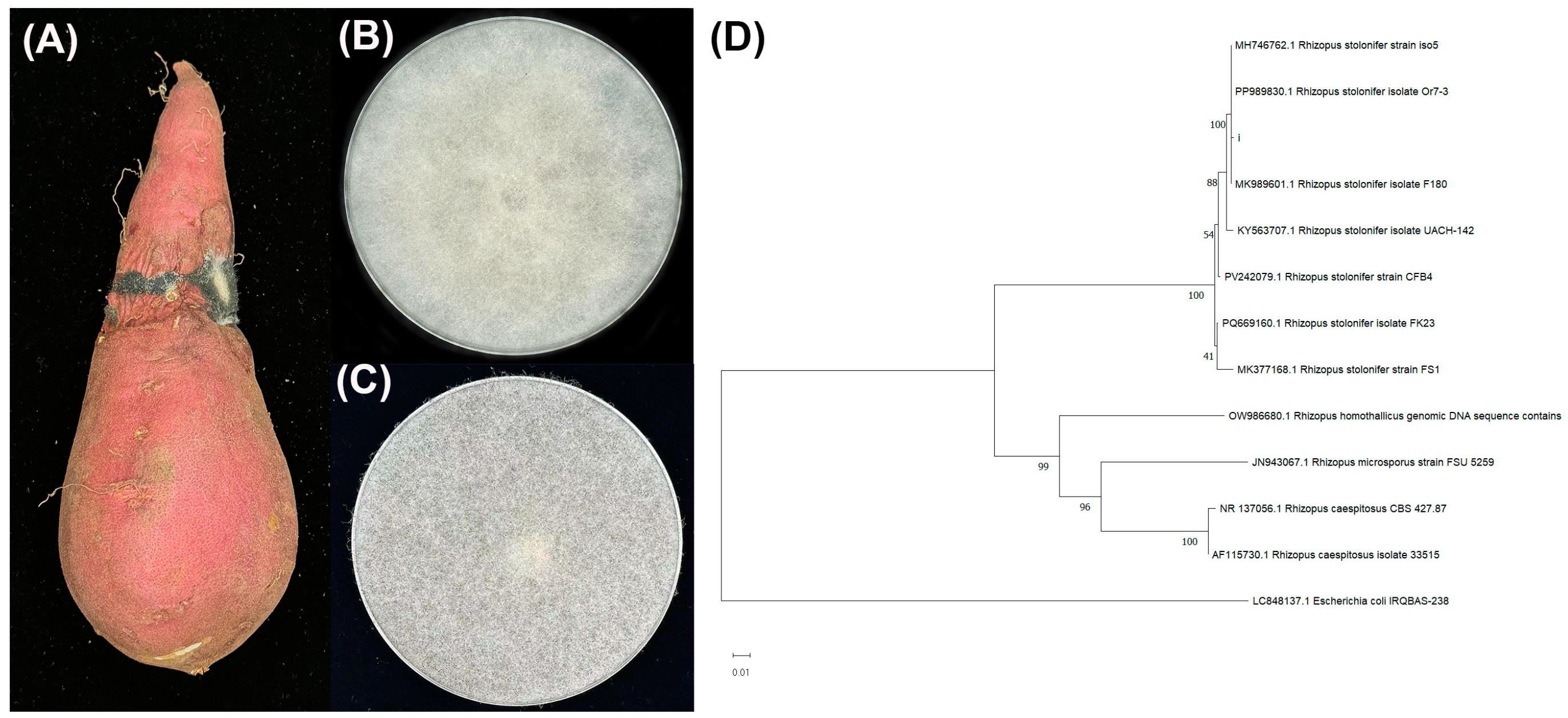
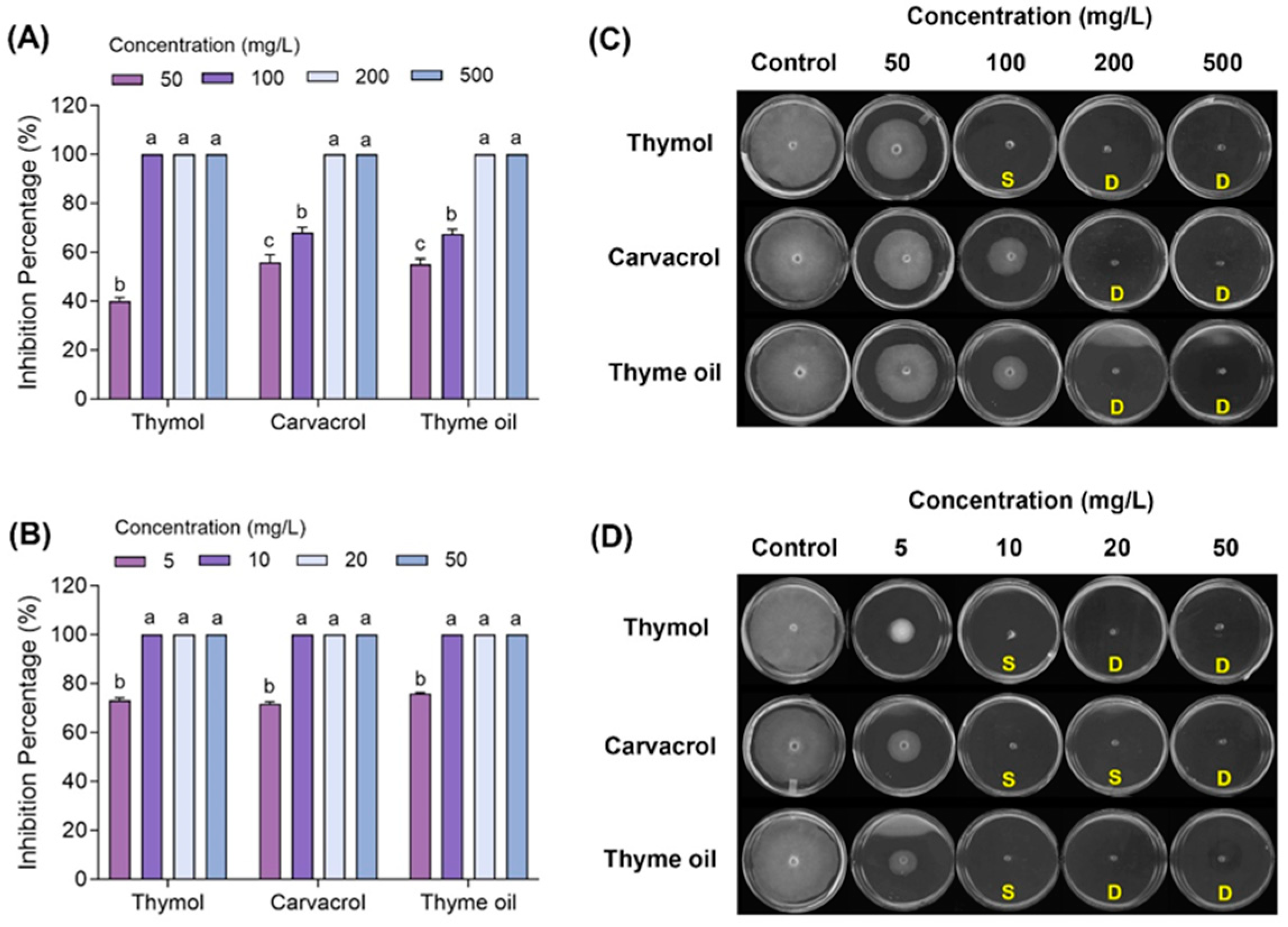
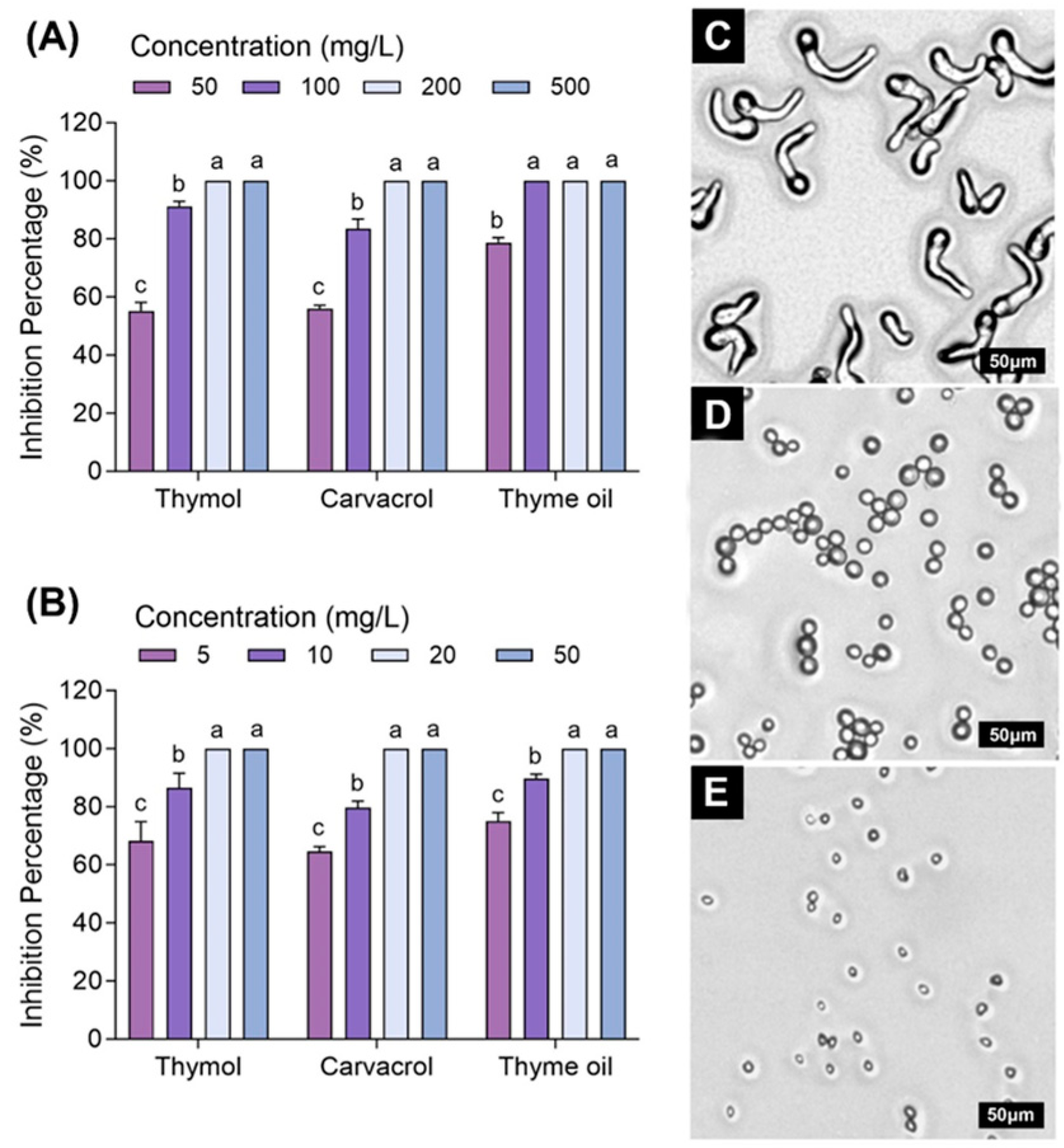
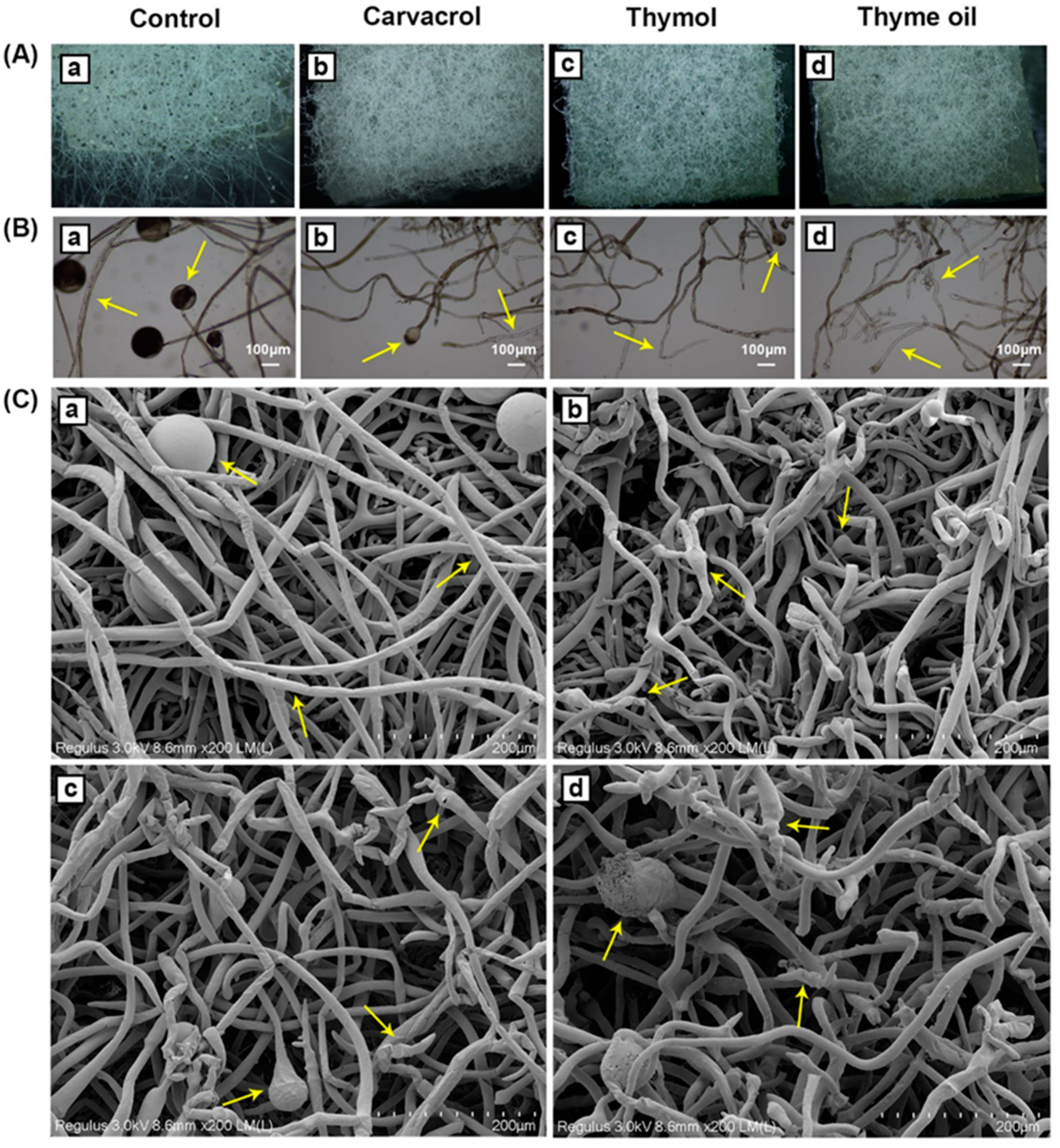
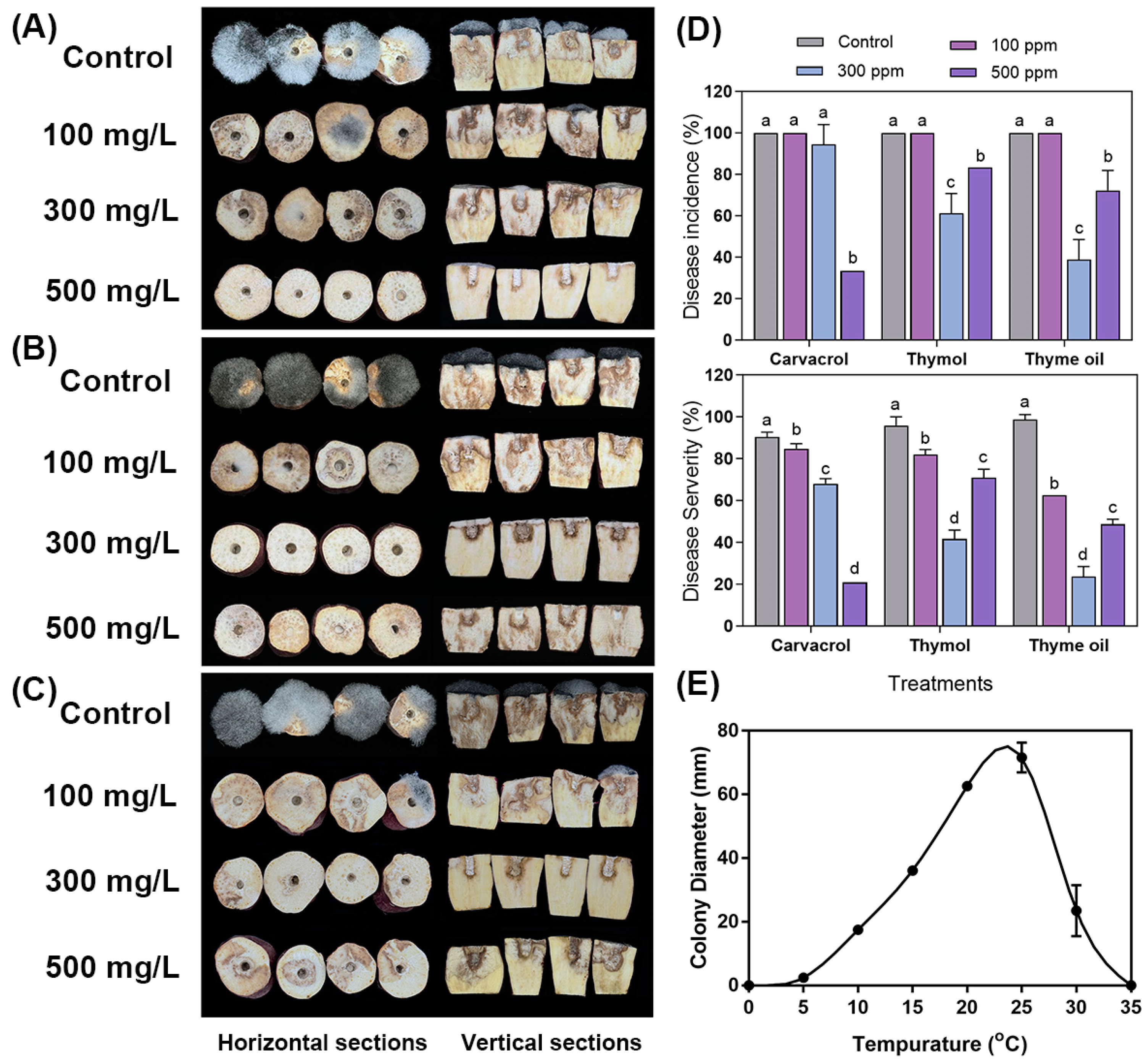
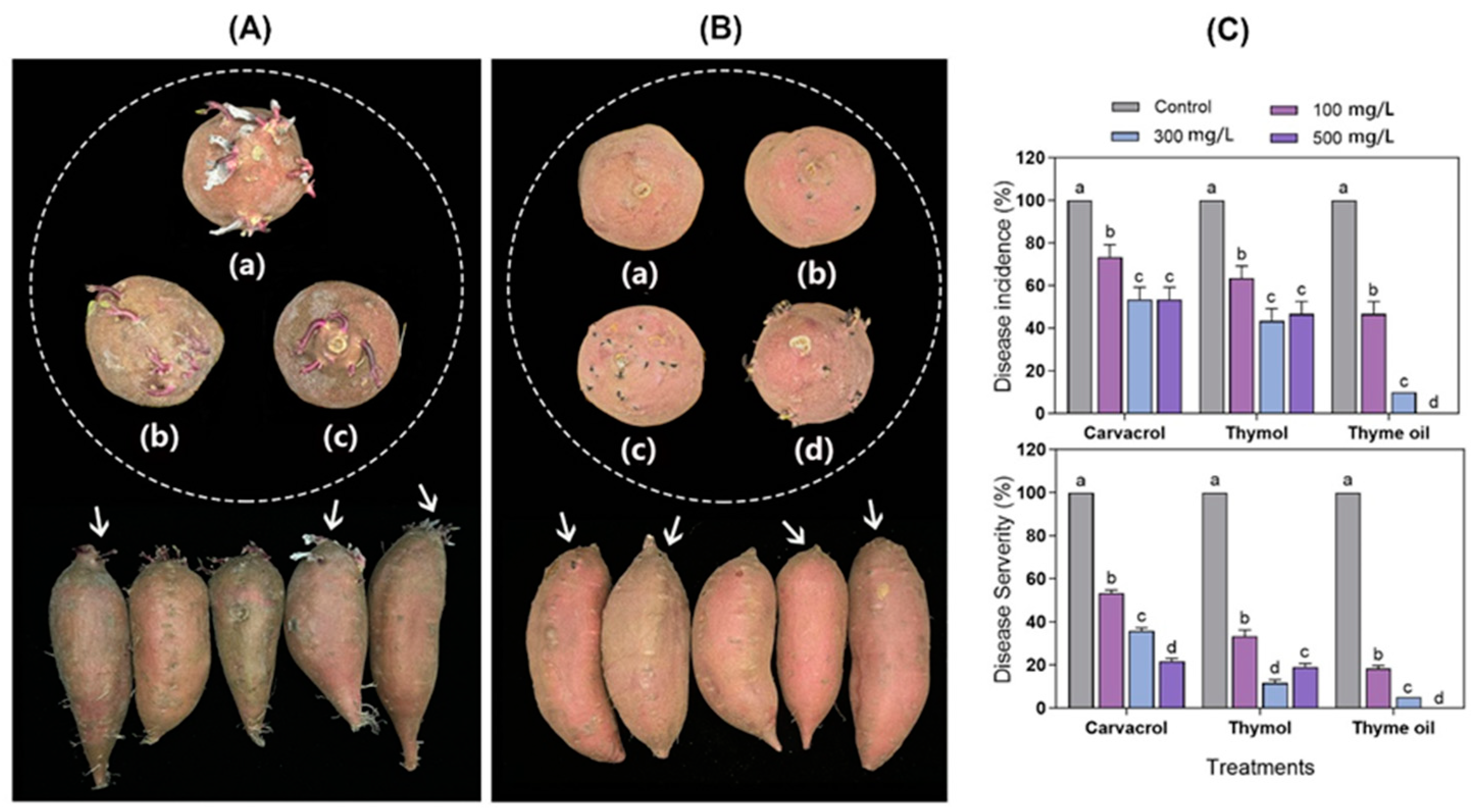

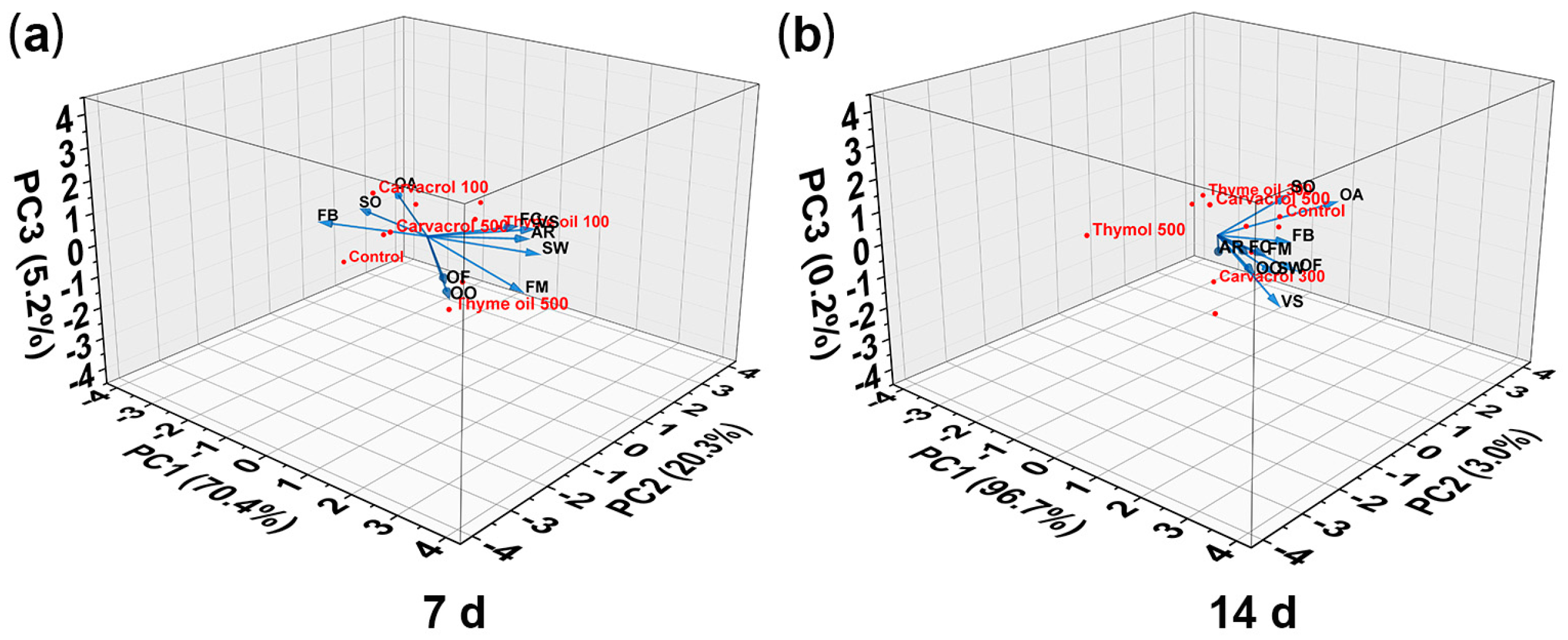
| Number | RT | Compounds | Average Abundance (Total Ion Current × 106) |
|---|---|---|---|
| Thyme Oil | |||
| 1 | 21.679 | α-Pinene | 689.55 |
| 2 | 22.45 | Camphene | 209.71 |
| 3 | 23.732 | β-Myrcene | 376.51 |
| 4 | 24.694 | β-Pinene | 22.26 |
| 5 | 25.392 | o-Cymene | 35.70 |
| 6 | 25.709 | p-Cymene | 3207.05 |
| 7 | 25.819 | D-Limonene | 25.37 |
| 8 | 26.037 | Eucalyptol | 308.11 |
| 9 | 27.034 | γ-Terpinene | 1481.03 |
| 10 | 28.448 | Linalool | 1261.57 |
| 11 | 31.131 | Camphor | 533.46 |
| 12 | 31.44 | Isoborneol | 197.53 |
| 13 | 31.755 | Borneol | 315.01 |
| 14 | 32.047 | 4-Terpinenol | 224.87 |
| 15 | 35.989 | Thymol | 5037.46 |
| 16 | 36.354 | Carvacrol | 932.21 |
| 17 | 36.692 | 2-(1-Methylpropyl)phenol | 53.95 |
| 18 | 38.466 | Eugenol | 12.18 |
| 19 | 39.605 | α-Copaene | 20.39 |
| 20 | 41.356 | Caryophyllene | 561.03 |
| 21 | 42.459 | Humulene | 62.07 |
| 22 | 46.711 | Caryophyllene oxide | 155.99 |
| Treatments | Weight Loss (100%) | Firmness (N) | Starch (mg/g Fresh Weight) | Carotenoids (mg/100 g Fresh Weight) | Flavonoids (mg/100 g Fresh Weight) | |
|---|---|---|---|---|---|---|
| Before storage | 25.10 ± 0.92 a | 76.58 ± 2.31 b | 3.54 ± 0.12 b | 50.14 ± 1.67 a | ||
| After storage | ||||||
| Control | 0.19 ± 0.02 a | 24.14 ± 0.44 a | 79.98 ± 2.48 ab | 3.66 ± 0.07 ab | 43.74 ± 2.51 b | |
| Carvacrol | 100 mg/L | 0.16 ± 0.01 b | 24.27 ± 0.30 a | 81.79 ± 4.01 ab | 3.66 ± 0.19 ab | 42.91 ± 3.79 b |
| 300 mg/L | 0.17 ± 0.01 ab | 24.31 ± 0.49 a | 80.12 ± 3.29 ab | 3.67 ± 0.13 ab | 42.76 ± 1.92 b | |
| 500 mg/L | 0.17 ± 0.01 ab | 24.45 ± 0.50 a | 80.81 ± 2.69 ab | 3.67 ± 0.11 ab | 44.74 ± 2.05 b | |
| Thymol | 100 mg/L | 0.17 ± 0.01 ab | 24.37 ± 0.64 a | 81.28 ± 2.38 ab | 3.65 ± 0.24 ab | 42.69 ± 0.89 b |
| 300 mg/L | 0.17 ± 0.00 ab | 24.96 ± 0.48 a | 84.81 ± 1.96 a | 3.72 ± 0.12 ab | 45.08 ± 1.90 b | |
| 500 mg/L | 0.17 ± 0.01 ab | 24.43 ± 0.63 a | 84.70 ± 2.81 a | 3.67 ± 0.27 ab | 43.62 ± 1.52 b | |
| Thyme oil | 100 mg/L | 0.17 ± 0.01 ab | 24.64 ± 0.45 a | 84.36 ± 2.44 a | 3.71 ± 0.14 ab | 44.81 ± 2.81 b |
| 300 mg/L | 0.17 ± 0.01 ab | 25.30 ± 0.51 a | 84.38 ± 3.29 a | 3.68 ± 0.10 ab | 44.56 ± 1.99 b | |
| 500 mg/L | 0.17 ± 0.00 ab | 24.91 ± 1.01 a | 84.42 ± 2.37 a | 3.96 ± 0.10 a | 47.10 ± 3.73 ab | |
| Treatments | Adhesive Force(N) | Adhesiveness (mJ) | Cohesiveness (Ratio) | Springiness (mm) | Gumminess (N) | Chewiness (mj) | |
|---|---|---|---|---|---|---|---|
| Before storage | −0.10 ± 0.00 b | 0.0072 ± 0.000 a | 0.68 ± 0.03 b | 1.39 ± 0.06 a | 103.41 ± 10.37 a | 131.55 ± 8.67 b | |
| After storage | |||||||
| Control | −0.08 ± 0.00 ab | 0.0067 ± 0.000 a | 0.72 ± 0.02 ab | 1.36 ± 0.08 a | 96.56 ± 6.65 a | 144.43 ± 9.97 ab | |
| Carvacrol | 100 mg/L | −0.08 ± 0.01 ab | 0.0073 ± 0.001 a | 0.76 ± 0.02 a | 1.36 ± 0.05 a | 103.33 ± 9.74 a | 142.60 ± 8.01 ab |
| 300 mg/L | −0.08 ± 0.01 ab | 0.0066 ± 0.003 a | 0.75 ± 0.06 ab | 1.38 ± 0.05 a | 94.34 ± 8.16 a | 143.29 ± 11.67 ab | |
| 500 mg/L | −0.08 ± 0.01 ab | 0.0080 ± 0.000 a | 0.76 ± 0.02 a | 1.50 ± 0.10 a | 98.67 ± 4.16 a | 145.03 ± 11.35 ab | |
| Thymol | 100 mg/L | −0.08 ± 0.02 ab | 0.0091 ± 0.000 a | 0.75 ± 0.03 ab | 1.39 ± 0.09 a | 105.28 ± 8.95 a | 143.56 ± 11.15 ab |
| 300 mg/L | −0.06 ± 0.01 a | 0.0073 ± 0.001 a | 0.75 ± 0.03 ab | 1.37 ± 0.08 a | 104.56 ± 9.87 a | 143.71 ± 10.73 ab | |
| 500 mg/L | −0.08 ± 0.01 ab | 0.0090 ± 0.000 a | 0.75 ± 0.03 ab | 1.43 ± 0.11 a | 105.97 ± 7.76 a | 144.08 ± 8.48 ab | |
| Thyme oil | 100 mg/L | −0.06 ± 0.01 a | 0.0066 ± 0.003 a | 0.75 ± 0.07 a | 1.43 ± 0.06 a | 94.00 ± 5.44 a | 145.39 ± 17.63 ab |
| 300 mg/L | −0.07 ± 0.02 a | 0.0090 ± 0.000 a | 0.76 ± 0.04 a | 1.45 ± 0.08 a | 98.06 ± 7.48 a | 142.77 ± 4.44 ab | |
| 500 mg/L | −0.06 ± 0.01 a | 0.0088 ± 0.001 a | 0.73 ± 0.01 ab | 1.51 ± 0.07 a | 105.98 ± 8.12 a | 163.67 ± 12.75 a | |
| Treatments | Hue | Chroma | Lightness (L) | ||||
|---|---|---|---|---|---|---|---|
| Day 0 | Day 7 | Day 0 | Day 7 | Day 0 | Day 7 | ||
| Control | 25.81 ± 1.54 bc | 29.96 ± 1.67 ab | 19.41 ± 0.24 b | 18.58 ± 1.15 b | 36.13 ± 0.87 a | 34.90 ± 2.46 abc | |
| Carvacrol | 100 mg/L | 25.36 ± 1.12 c | 29.15 ± 0.52 b | 22.66 ± 0.43 a | 21.81 ± 0.85 a | 35.47 ± 2.75 a | 33.03 ± 2.49 c |
| 300 mg/L | 26.60 ± 0.69 abc | 30.40 ± 1.36 ab | 20.29 ± 1.56 ab | 19.67 ± 1.29 ab | 38.03 ± 0.47 a | 36.63 ± 1.27 ab | |
| 500 mg/L | 26.73 ± 0.80 abc | 30.85 ± 2.28 ab | 20.23 ± 1.51 ab | 19.71 ± 1.18 ab | 35.37 ± 1.86 a | 33.50 ± 1.21 abc | |
| Thymol | 100 mg/L | 27.06 ± 1.19 abc | 31.52 ± 0.75 ab | 21.46 ± 1.88 ab | 20.57 ± 0.79 ab | 37.47 ± 1.37 a | 35.37 ± 2.14 abc |
| 300 mg/L | 28.14 ± 1.60 ab | 32.51 ± 2.36 a | 19.48 ± 0.80 b | 18.61 ± 0.66 b | 37.67 ± 2.53 a | 35.33 ± 0.49 abc | |
| 500 mg/L | 27.17 ± 1.94 abc | 31.03 ± 1.54 ab | 21.01 ± 1.64 ab | 20.68 ± 1.96 ab | 38.87 ± 2.90 a | 36.10 ± 1.77 abc | |
| Thyme oil | 100 mg/L | 25.32 ± 1.10 c | 29.92 ± 1.51 ab | 21.59 ± 1.98 ab | 20.44 ± 0.90 ab | 36.50 ± 0.35 a | 34.43 ± 1.46 abc |
| 300 mg/L | 27.82 ± 1.26 ab | 31.40 ± 1.45 ab | 21.81 ± 0.66 ab | 20.47 ± 1.92 ab | 35.73 ± 1.36 a | 33.43 ± 0.68 abc | |
| 500 mg/L | 28.37 ± 0.75 a | 32.13 ± 1.92 ab | 22.26 ± 1.19 a | 21.16 ± 0.49 a | 38.47 ± 1.80 a | 36.77 ± 1.32 a | |
Disclaimer/Publisher’s Note: The statements, opinions and data contained in all publications are solely those of the individual author(s) and contributor(s) and not of MDPI and/or the editor(s). MDPI and/or the editor(s) disclaim responsibility for any injury to people or property resulting from any ideas, methods, instructions or products referred to in the content. |
© 2025 by the authors. Licensee MDPI, Basel, Switzerland. This article is an open access article distributed under the terms and conditions of the Creative Commons Attribution (CC BY) license (https://creativecommons.org/licenses/by/4.0/).
Share and Cite
Wu, G.; Fan, C.; Zang, X.; Wang, B.; Chen, Y.; Kou, J.; Zhu, G. The Control of Postharvest Soft Rot Caused by Rhizopus stolonifer on Kokei No. 14 Organic Sweet Potato Roots by Carvacrol, Thymol, and Thyme Oil. Foods 2025, 14, 1273. https://doi.org/10.3390/foods14071273
Wu G, Fan C, Zang X, Wang B, Chen Y, Kou J, Zhu G. The Control of Postharvest Soft Rot Caused by Rhizopus stolonifer on Kokei No. 14 Organic Sweet Potato Roots by Carvacrol, Thymol, and Thyme Oil. Foods. 2025; 14(7):1273. https://doi.org/10.3390/foods14071273
Chicago/Turabian StyleWu, Guangwei, Chenqi Fan, Xueqian Zang, Bei Wang, Yanli Chen, Jingjing Kou, and Guopeng Zhu. 2025. "The Control of Postharvest Soft Rot Caused by Rhizopus stolonifer on Kokei No. 14 Organic Sweet Potato Roots by Carvacrol, Thymol, and Thyme Oil" Foods 14, no. 7: 1273. https://doi.org/10.3390/foods14071273
APA StyleWu, G., Fan, C., Zang, X., Wang, B., Chen, Y., Kou, J., & Zhu, G. (2025). The Control of Postharvest Soft Rot Caused by Rhizopus stolonifer on Kokei No. 14 Organic Sweet Potato Roots by Carvacrol, Thymol, and Thyme Oil. Foods, 14(7), 1273. https://doi.org/10.3390/foods14071273





